Pruning and Sparsity¶
Abstract
- Introduction to Pruning
- What is pruning?
- How should we formulate pruning?
- Determine the Pruning Granularity
- In what pattern should we prune the neural network?
- Determine the Pruning Criterion
- What synapses/neurons should we prune?
- Determine the Pruning Ratio
- What should target sparsity be for each layer?
- Fine-tune/Train Pruned Neural Network
- How should we improve performance of pruned models?
- System Support for Sparsity
- EIE: Weight Sparsity + Activation Sparsity for GEMM
- NVIDIA Tensor Core: M:N Weight Sparsity Sparsity
- TorchSparse & PointAcc: Activation Sparsity for Sparse Convolution
MLPerf (the Olympic Game for AI Computing)
benchmark, 基于 BERT, 要求保持 99% 的 accuracy,衡量加速比。可以发现 open division 相较于 closed 获得了 4.5x 的加速比。
- closed division: 只靠硬件加速,不能改变网络结构(比如权重数量、精度)。
- open division: 可以改变网络结构,比如剪枝、降低精度、压缩等技巧。
可以看出,通过剪枝改变网络结构可以显著地提网络性能。
Introduction to Pruning¶
- Motivation: 内存很昂贵,会消耗大量的能源。
-
Idea: Make neural network smaller by removing synapses and neurons.
我们去掉神经网络里的一些小的连接(去掉即让权重为 0),使网络变得更小。
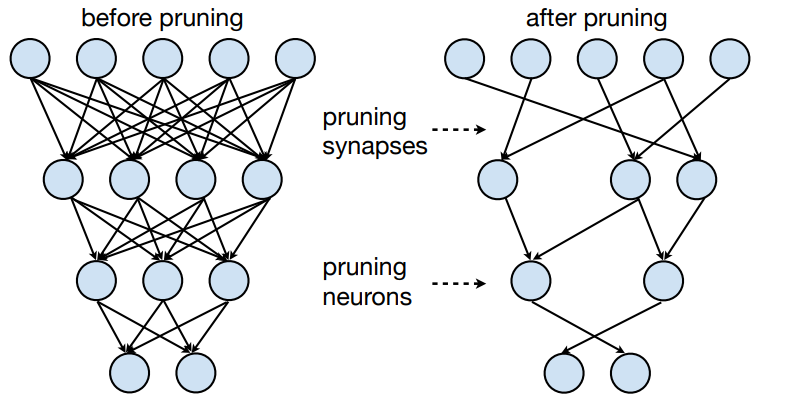
-
大体流程如下:
- Train Connectivity 首先我们训练至收敛
- Prune Connections 然后我们去掉一些连接
- Train Weights 最后我们重新训练权重
- 第 3 步执行完后可以继续第 2 步,如此迭代。
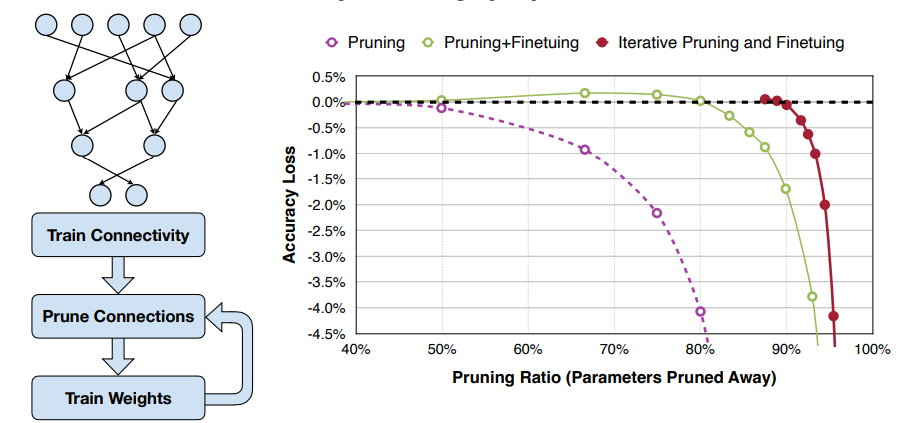
Example
可以看到不同的网络有不同的 pruning ration,其中 VCG-12 可以达到 12x 的 reduction,说明较大的网络内部的冗余也更多。对于较小的网络如 SqueezeNet,我们依然可以达到 3.2x 的 reduction。
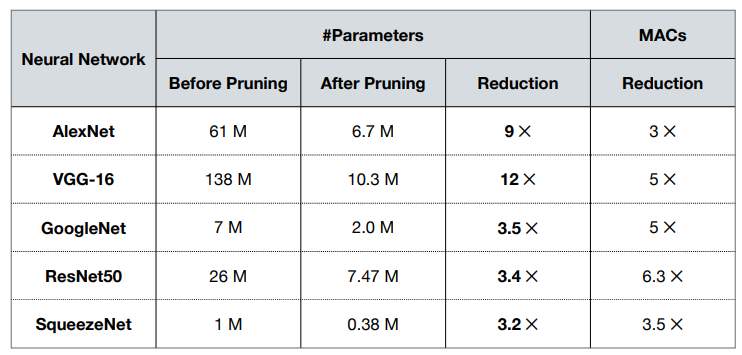
Pruning the NeuralTalk LSTM does not hurt image caption quality.
即使我们减去了大部分连接,但是如果这个比例在接受范围内,那么不会影响分类的质量。如下面的前三个图,我们可以看到剪枝后提取的信息足够用来识别物体。但是对于第四个图,我们剪枝了 95%,导致了信息捕获不足。
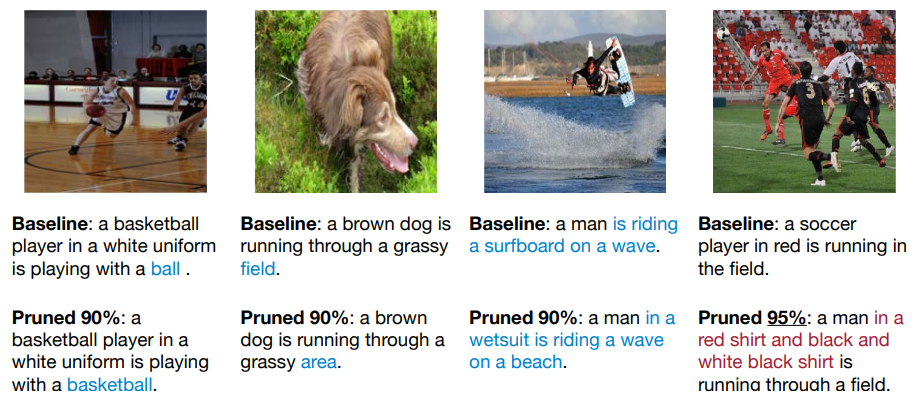
-
通常我们将剪枝表示为
\[ \arg\min\limits_{\mathbf{W}_p}L(\mathbf{x};\mathbf{W_p})\quad s.t.\ \|\mathbf{W}_p\|_0\leq N \]其中,
- \(L\) 是神经网络训练的目标函数。
- \(\mathbf{x}\) 是输入,\(\mathbf{W}\) 是原始权重,\(\mathbf{W}_p\) 是剪枝后的权重。
- \(\|\cdot\|_0\) 表示非零元素的个数,\(N\) 表示我们希望有多少权重保持非零。
Determing the Pruning Granularity¶
-
不同粒度的剪枝会有不同的效果,如下图所示:
- Fine-grained/Unstructured:
- More flexible pruning index choice
- Hard to accelerate (irregular)
- Coarse-grained/Structured:
- Less flexible pruning index choice (a subset of the fine-grained case)
- Easy to accelerate (just a smaller matrix!)

- Fine-grained/Unstructured:
-
上面是对于 2D 的矩阵,对于卷积层,我们有 4 个维度 \([c_0, c_i, k_h,k_w]\),这给了我们更多的剪枝粒度的选择。
- \(c_i\): 输入通道数; \(c_0\): 输出通道数; \(k_h,k_w\): kernel 的高和宽。
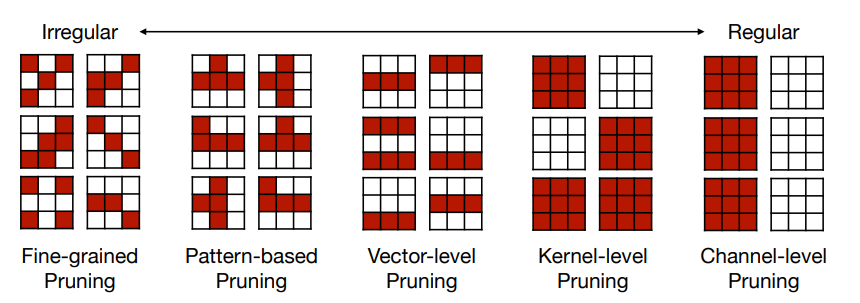
- Fine-grained Pruning
- 逐个元素选择是否剪枝,通常可以得到更高的剪枝率。但是需要注意的是,参数的减少不能直接转为 speed up,还需要考虑硬件上的效率。
- 细粒度的剪枝只能在某些特定硬件上得到加速(如 EIE),但是在 GPU 上不能得到加速。
-
Pattern-based Pruning: N:M sparsity
- N:M sparsity 是指每连续 M 个元素,我们修建掉 N 个。常用的情况是 2:4 sparsity(50%).
-
这种剪枝方式可以在 NVIDIA’s Ampere GPU 架构上得到加速。如下图所示,我们会存修剪后的非零值,同时有一个额外的索引块来存非零值的原始位置。

-
通常可以保持精度(在各种任务中经过测试)。
-
Channel Pruning
- 直接去掉某些通道,好处是可以直接获得加速(相当于降低了 \(c\) 的大小)。
- 但是剪枝率也较低。这个方法被广泛使用,因为足够简单。
- 对于不同层,我们可以采用不同的剪枝率,这样能在相同的精度下获得更低的延时。

Determine the Pruning Criterion¶
Selection of Synapses to Prune¶
- 当剪枝参数时,我们希望移除不太重要(less important)的参数,这样我们剪枝后的神经网络能获得更好的性能。
-
Magnitude-based Pruning
- 启发式的剪枝准测,我们把认为有更大绝对值的权重更重要。
- 对于 element-wise 的剪枝,\(Importance=|W|\).
- 对于 row-wise 的剪枝,\(Importance=\sum\limits_{i\in S}\sum|w_i|\) 或者 \(Importance=\sum\limits_{i\in S}\sqrt{\sum|w_i|^2}\). 其中 \(\mathbf{W}^{(S)}\) 是权重 \(\mathbf{W}\) 的 \(S\) 结构集合,这里分别是 L1 和 L2 范数。
- 也可以使用 Lp 范数,即 \(\|\mathbf{W}_p^{(S)}\| = \left(\sum\limits_{i\in S}|w_i|^p\right)^{1/p}\).
Example



-
Scaling-based Pruning
- 这个剪枝方法用于 filter pruning。在卷积层里每个 filter 都有一个 scaling factor 缩放因子(可训练的),把这个因子和输出通道的输出乘起来。缩放因子较小的通道将被修剪掉。
- 这个缩放因子可以用在 BatchNorm 层里。
Example

-
Second-Order-based Pruning
- 通过泰勒级数推导误差,随后通过 Hessian 矩阵的特征值来评估权重的重要性。
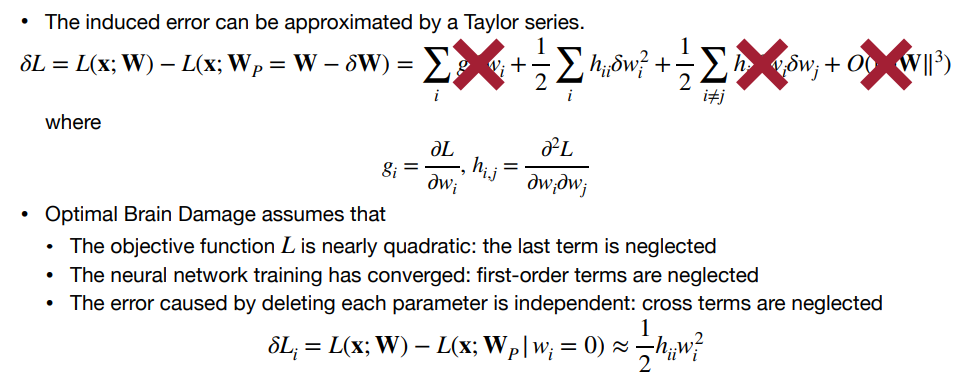
- 通过泰勒级数推导误差,随后通过 Hessian 矩阵的特征值来评估权重的重要性。
Selection of Neurons to Prune¶
- 我们还可以修剪神经元/激活值(粗粒度,因为去掉神经元相当于把所有相关的连接权重去掉了),类似地我们希望移除不那么有用(less useful)的神经元。
-
Percentage-of-Zero-Based Pruning
- ReLU 激活函数会在输出里产生 0,因此我们可以采用 Average Percentage of Zero activations (APoZ) 来衡量权重的重要性。APoZ 越小,说明权重越重要。
Example
在这里我们基于 channel 做修剪:可以看到 channel 2 的 APoZ 最小,因此我们可以修剪掉这个 channel。

-
Regression-based Pruning
-
因为大模型下微调不那么容易,我们可以单独关注某层,通过回归的方法,最小化重建(即从输入到输出)对应层输出的 reconstruction error 误差。
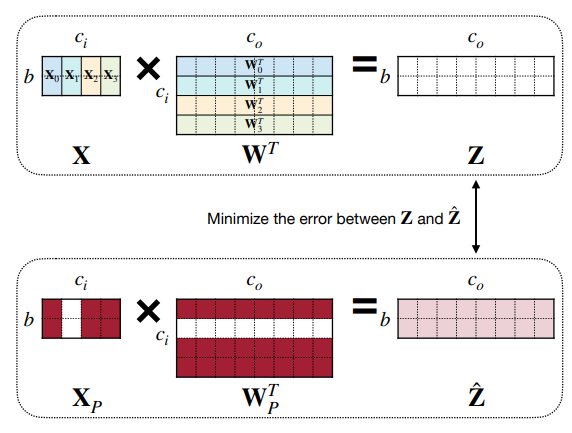
-
令 \(\mathbf{Z}=\mathbf{X}\mathbf{W}^\top=\sum\limits_{c=0}^{c_i -1}\mathbf{X}_c \mathbf{W}_c^\top\), 那么我们要做的就是
\[ \arg\min\limits_{\mathbf{W}, \beta}\|\mathbf{Z}-\hat{\mathbf{Z}}|_F^2 = \|\mathbf{Z} - \sum\limits_{c=0}^{c_i-1}\beta_c \mathbf{X}_c \mathbf{W}_c^\top\|_F^2 \quad s.t.\ \|\beta_0\| \leq N_c \]- \(\beta\) 是长为 \(c_i\) 的向量的通道系数,\(\beta_c=0\) 说明我们修剪掉了通道 \(c\)。
- \(N_c\) 是我们希望保留的通道数。
- 解决这个问题,可以通过:
- 固定 \(\mathbf{W}\), 解出 \(\beta\) 用于通道选择。
- 固定 \(\beta\),解出 \(\mathbf{W}\) 用来最小化重建误差。
-
Determine the Pruning Ratio¶
- Non-uniform pruning is better than uniform shrinking. 非规则的剪枝比规则的剪枝更好。
-
需要分析每一层的 sensitivity 敏感度,然后根据 sensitivity 来决定各层的剪枝率。有的层更加敏感(比如第一层),有的层冗余更多(比如全连接层)。
- 选择模型中的 \(L_i\) 层,剪枝 \(L_i\) 层至剪枝率 \(r\in \{0, 0.1, 0.2, \ldots, 0.9\}\)(或者使用其他步长),随后观察模型的精确度下降情况 \(\nabla Acc_r^i\)。重复这个步骤知道所有层都被分析结束。
- 最后我们可以选择一个 threshold \(T\), 即精度至少要保持在 \(T\) 以上,然后为每一层选择对应的剪枝率。
- 这是一种启发式的方法。同时这里我们假设了不同的层之间是相互独立的,不会互相干扰。但实际上层与层之间存在相互关系,因此这样的方法并不是最优的。
Example
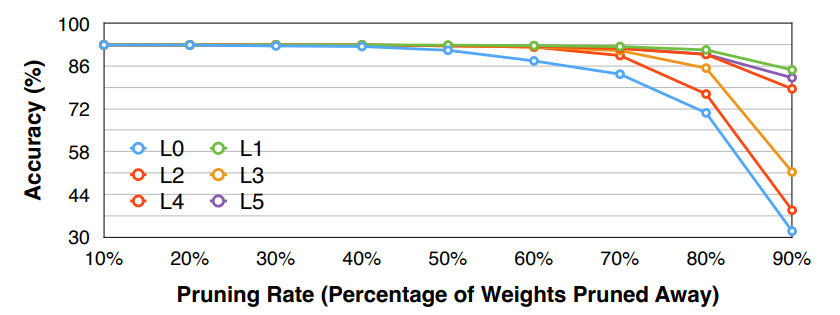
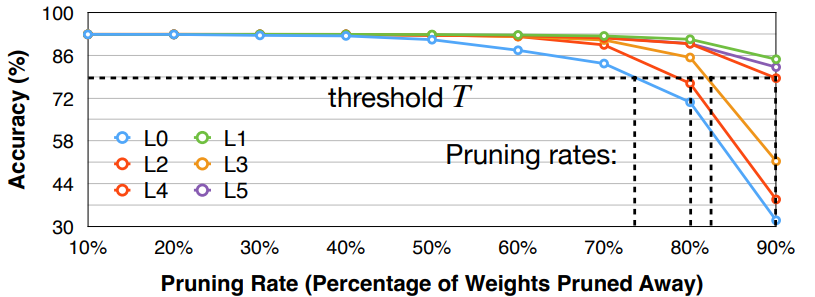
Note
需要注意的是剪枝率并没有反映 layer size,比如上面的例子中虽然 L1 可以很激进地修剪,但可能 L1 本来就只有 20 个参数,这样的剪枝率并不会对整个网络的大小产生很大的影响。
在 LLM(Transformer) 背景下,各个层都是 homegeneous 的,即每层的大小不会有太大的变化。但是对于 CNN,每层的大小都是不同的,因此我们需要考虑每层的 size。
-
Automatic Pruning
- 在过去,剪枝的比例是人工选择的,需要我们通过实验试错来确定最终比例。我们希望有一个 push-the-button 的方法来自动选择最佳的剪枝比例。
-
AMC (AutoML for Model Compression) 是一个自动选择剪枝比例的方法,它通过强化学习来选择最佳的剪枝比例。
这里实际上我们会把 reward 设为 \(-Error*\log(FLOP)\) 用来平衡精度和 FLOP(近似延时)的关系。
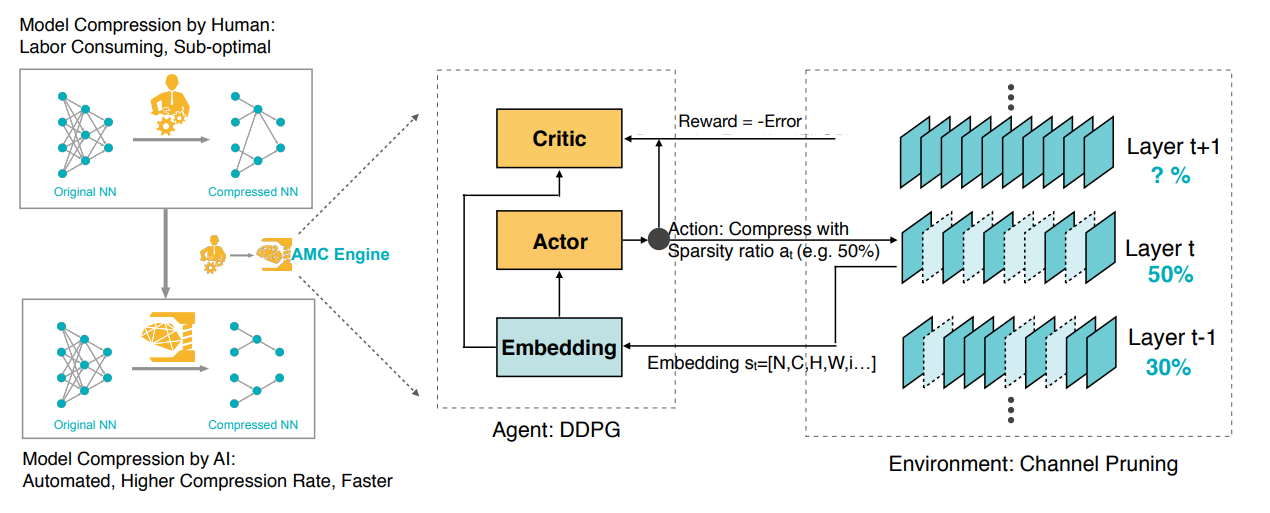
最终我们可以得到比人工修剪更好的结果。
-
NetAdapt: A rule-based iterative/progressive method
Fine-tune/Train Pruned Neural Network¶
- 剪枝后模型的精度会下降,我们需要微调剪枝后的模型来恢复精度,并可以尝试让剪枝率更高。
-
Learning rate for fine-tuning is usually 1/100 or 1/10 of the original learning rate.
经验上会这么设置微调时的学习率,因为在剪枝前模型已经收敛了,我们不需要太大的学习率来调整模型。
-
Iterative Pruning
先训练到收敛,随后进行剪枝。剪枝后再次训练至收敛。随后可以进一步提高剪枝率,如此迭代。
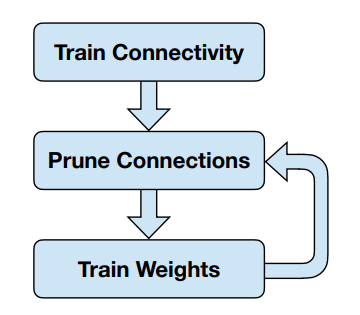
-
Regularization
- 训练或者微调时,我们会把正则化项 regularization 加到损失上。
- 惩罚非零参数,目的是尽可能地多修剪参数。
- 鼓励更小的权重,这样下一轮迭代就可能修剪掉这些权重。
- 常见的正则化 \(L'=L(\mathbf{x};\mathbf{W})+\lambda |\mathbf{W}|\), \(L'=L(\mathbf{x};\mathbf{W})+\lambda \|\mathbf{W}\|^2\)
- 训练或者微调时,我们会把正则化项 regularization 加到损失上。
System Support for Sparsity¶
EIE: Weight Sparsity + Activation Sparsity for GEMM¶
-
The First DNN Accelerator for Sparse, Compressed Model
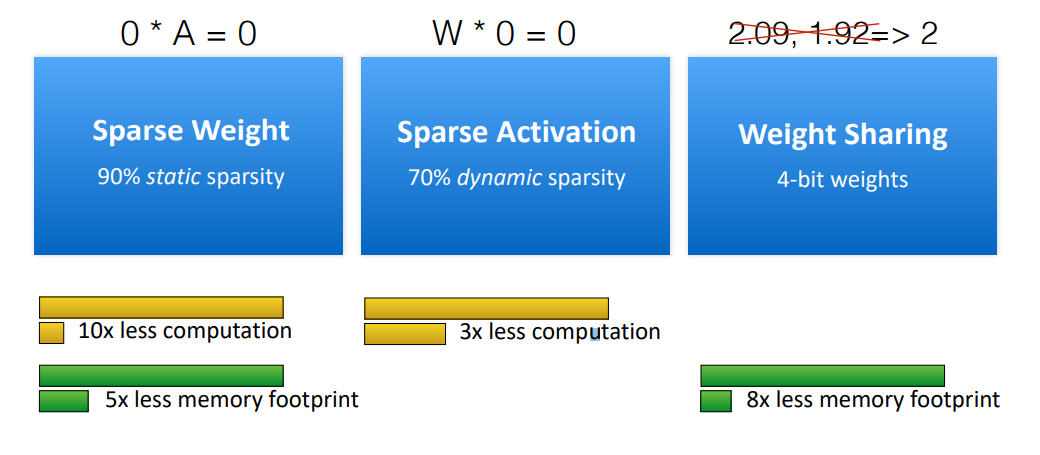
0 是一个特殊的值,因为 0 的权重/激活值不需要计算/存储(结果肯定为 0),从而可以节省计算和存储。
why weight 10x less computation while 5x less memory footprint
因为为了表示 sparse matrix,我们还需要存索引,因此存储空间的节省不如计算量的节省。
-
Parallelization on Sparsity
Example
这里 relative index 表示和上一个非零值的相对位置,column pointer 表示是否开始新的一列。
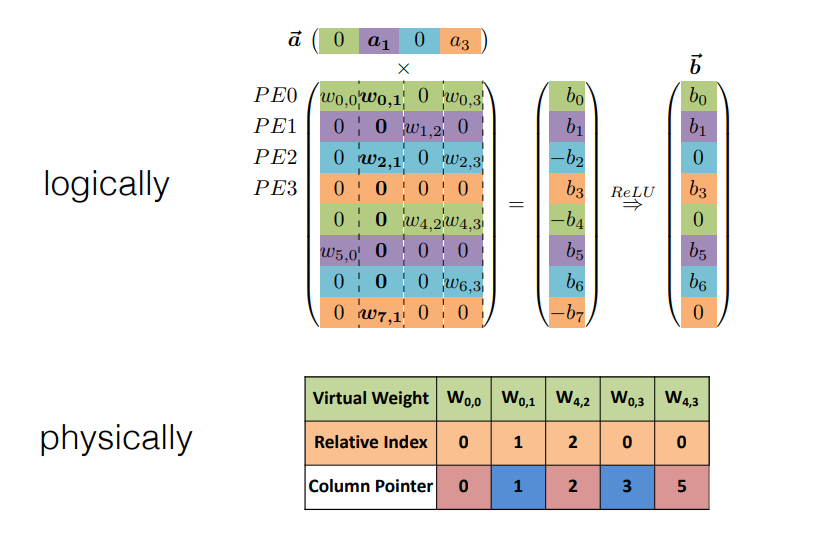
-
Micro Architecture for each PE
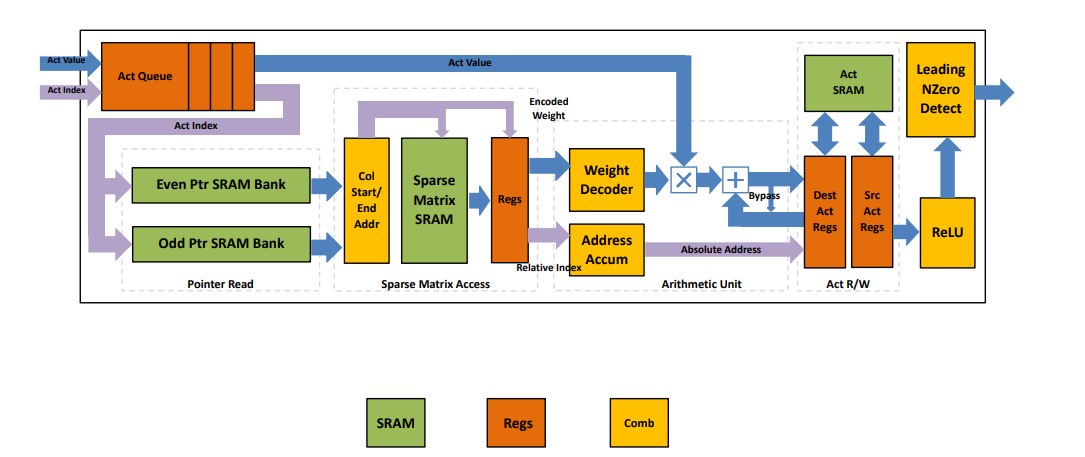
总结 EIE
- Pros:
- EIE demonstrated that special-purpose hardware can make it cost-effective to do sparse operations with matrices that are up to 50% dense
- EIE exploits both weight sparsity and activation sparsity, not only saves energy by skipping zero weights, but also saves the cycle by not computing it.
- EIE supports fine-grained sparsity, and allows pruning to achieve a higher pruning ratio.
- Aggressive weight quantization (4bit) to save memory footprint. To maintain accuracy, EIE decodes the weight to 16bit and uses 16bit arithmetic. W4A16 approach is reborn in LLM: GPTQ, AWQ, llama.cpp, MLC LLM
- Cons:
- EIE isn’t as easily applied to arrays of vector processors — improve: structured sparsity (N:M sparsity)
- EIE’s Control flow overhead, storage overhead — improve: coarse grain sparsity
- EIE only support FC layers - actually reborn in LLM
- EIE fits everything on SRAM - practical for TinyML, not LLM
The first principle of efficient AI computing is to be lazy!
Avoid redundant computation, quickly reject the work, or delay the work.
我们设想未来的人工智能模型将在各种粒度和结构上稀疏。与专门的加速器共同设计,稀疏模型将变得更加高效和易于访问。
Related Work
- Generative AI: spatial sparsity [SIGE, NeurIPS’22]
- Transformer: token sparsity, progressive quantization [SpAtten, HPCA’21]
- Video: temporal sparsity [TSM, ICCV’19]
- Point cloud: spatial sparsity [TorchSparse, MLSys’22 & PointAcc, Micro’22]
NVIDIA Tensor Core: M:N Weight Sparsity Sparsity¶
TODO
TorchSparse & PointAcc: Activation Sparsity for Sparse Convolution¶
TODO